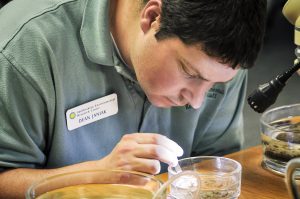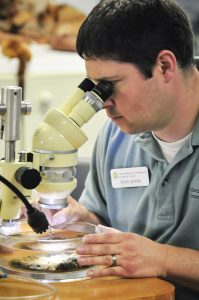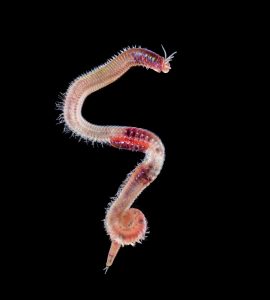
On the eastern coast of Florida, about 120 miles north of Miami, there is a very special research center: the Smithsonian Marine Station at Fort Pierce. It serves as a field station specializing in marine biodiversity and Florida ecosystems, especially that of the Indian River Lagoon – one of the most biologically-diverse estuaries in North America. The center is a destination for scientists around the world who are interested in studying the extraordinary biodiversity in the area as well as ocean and coastal processes at large.
In 2012, the Tennenbaum Marine Observation Network (TMON) was launched to further expand the Station’s contributions to worldwide coastal marine biodiversity and ecosystem research. Biologist Dean Janiak has worked there for the past year and a half. “I would consider myself a general marine ecologist with a particular interest in how marine invertebrate communities are both formed and maintained in space and time,” says Janiak. “When we travel out into the field and see communities of animals living in close proximity to each other, we could assume that they just randomly arrived there and have made a living. However, most species actually have gone through a harrowing adventure to get to where they are.”
 Janiak continues, “Besides how they got there, the animals themselves are unbelievably diverse. I would argue that within a half meter, in many parts of the ocean you could find more diversity than any zoo or aquarium could ever show you. Because of this, much of my interests are in not only why communities look the way they do but also what species or groups of species make up these communities. In particular, I do a lot of research in an unusual type of habitat – artificial habitats (docks, marinas, seawalls) – which are actually pretty common. While they tend to have a positive effect for those installing them (storm protection, recreational boating), we have little knowledge on how they function in terms of the animals on them and how they contribute to the overall system. For example, a large percentage of non-native species are found in these types of habitats, and one of the topics I am interested in is the consequences of these species spreading into more pristine, native habitat like seagrasses or reefs.”
Janiak continues, “Besides how they got there, the animals themselves are unbelievably diverse. I would argue that within a half meter, in many parts of the ocean you could find more diversity than any zoo or aquarium could ever show you. Because of this, much of my interests are in not only why communities look the way they do but also what species or groups of species make up these communities. In particular, I do a lot of research in an unusual type of habitat – artificial habitats (docks, marinas, seawalls) – which are actually pretty common. While they tend to have a positive effect for those installing them (storm protection, recreational boating), we have little knowledge on how they function in terms of the animals on them and how they contribute to the overall system. For example, a large percentage of non-native species are found in these types of habitats, and one of the topics I am interested in is the consequences of these species spreading into more pristine, native habitat like seagrasses or reefs.”
Such research is dependent upon information contained within published literature. “Each species is unique in its evolutionary journey and should be treated as such,” says Janiak. “Identifying a species and learning about how that species makes its living requires an extensive use of the library system.”
Traditionally, access to historic literature is difficult to obtain, even for researchers working at institutions with extensive library collections such as those that Janiak has access to through the Smithsonian Libraries. While Janiak is quick to point out that he benefits enormously from the e-journal subscriptions and robust interlibrary loan services offered by the Smithsonian, being stationed in Florida, away from the library base of his home institution, means that his opportunity to access the Libraries’ physical collections are limited. Even the speediest interlibrary loan services inevitably introduce delays into the research process.

The Biodiversity Heritage Library (BHL), however, is revolutionizing scientific research, providing researchers across the globe with free and immediate access to the information and publications they require to study life on Earth. “BHL is a great resource for trying to find things that have typically been forgotten,” says Janiak. “[It provides access to] literature that would be otherwise impossible to find or know that it even existed. From a research perspective, I use BHL as a starting to point to find taxonomic information on a particular species or group that I am working on. As we move closer and closer to new-age molecular approaches to identifying species, we are losing people who can simply look at an animal and tell you what it is and the interesting way that it makes a living. I think that much of this knowledge would be lost if BHL was not trying to keep this information available.”
In particular, BHL has proven to be a useful resource for the TMON project, providing information that supports research on global change. “TMON has at its core to understand biodiversity and how it changes through time,” explains Janiak. “I think that we are all aware that the climate is changing, and it is natural for change to occur. There are built-in positive and negative feedback loops that allow the climate to do so. I think the problem is that this change is happening at a rapid rate and we, in a single generation, can see this happening. It is therefore important to have access to a biodiversity library that has done so well to document the past, as this is vital to our understanding of the future.”

Be First to Comment